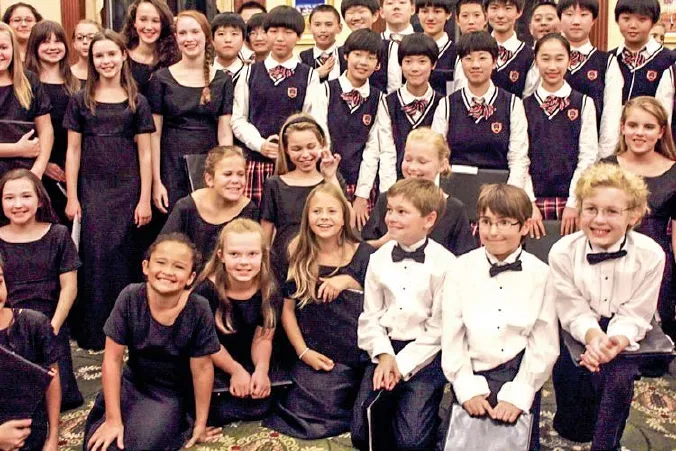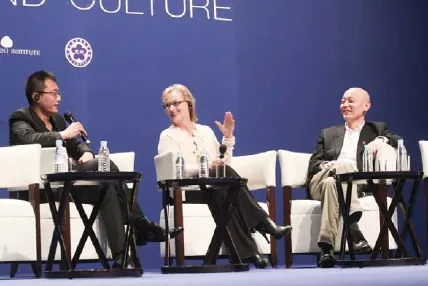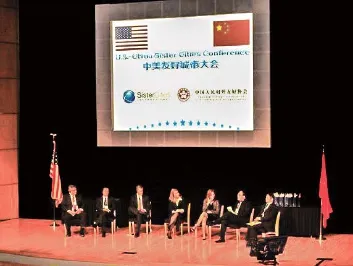跨洋结友谊 互利促共赢
跨洋结友谊 互利促共赢
涵盖了包括北美洲、南美洲在内的整个西半球和整个南太平洋地区,共有51个国家,其中有世界上唯一的超级大国美国,也有世界上最不发达国家海地、瓦努阿图、图瓦卢,这就是美洲大洋洲地区(以下简称“美大地区”)。远隔重洋,与其国别特点和地理因素呈现出的巨大差异相类似,美大地区的友城工作既有蓬勃发展的光鲜一面,也有挑战与机遇相互依存的困难一面。

2011 年7 月,首届中美省州长论坛在美国盐湖城召开。
“对我来说,你们就是美国”
时任国家副主席习近平于2012年初访问了美国艾奥瓦州马斯卡廷市,习主席在与27年前他访美时接待过他的美国老朋友们一起团聚交谈时,不无感慨地说:“阔别27年,这次再回到马斯卡廷,当年的印象又再度浮现,见到你们我感到非常亲切。这里给我留下如此深刻的印象,你们都难以体会,因为你们是我见到的第一批美国人,我对美国的第一印象来自你们,对我来说,你们就是美国。”
1985年当时在河北省正定县工作的习近平,率考察团来到艾奥瓦州访问,1992年艾奥瓦州的老朋友应习主席的邀请访华,到后来艾奥瓦州州长布兰斯塔德,这位美国有史以来做州长时间最长的州长发誓,一定要把艾奥瓦州变成对中国最友好的州,所有这些佳话和故事都起源于1983年河北省与艾奥瓦州结为友好省州。
包括友城交往在内的中美地方交往始终是中美关系稳步推进的重要动力之一。1979年中美两国建交以来,自湖北省与俄亥俄州、江苏省南京市与密苏里州圣路易斯市结为第一对友好省州和友好城市,中美两国目前已缔结46对友好省州和212对友好城市。37年来,伴随着我国进一步改革开放和中美关系的不断向前发展,双方在经贸合作、文化教育、技术交流和人员培训等各领域取长补短、相互学习,给两国人民带来了实实在在的利益。
近年来,中美共同实施了多项重要地方交流机制,两国友城交往逐渐呈现制度化与规范化趋势。例如,由中国人民对外友好协会(以下简称“全国友协”)负责举办的中美省州长论坛自2011年启动以来,已成功组织三届论坛和两次对话活动,习近平主席2015年访美时亲自出席第三届论坛并发表重要讲话。据不完全统计,共有美方33位州长或总督、中方26位省(自治区、直辖市)主要领导出席,就经济发展、环境保护等议题展开交流,取得了一系列合作成果,有力推动了两国地方务实合作;中美友城大会已于2014年和2015年连续在美举办,第三届中美友城大会将于今年11月18—19日在江西南昌举行,该机制已成为两国地方分享友城交流经验、探讨合作机遇的重要平台。
此外,全国友协每年还通过接待大量美国州长、副州长、市长、州议会领袖、州议员等重要地方政府官员访华,助力中美友城交往,推动双方友好省州和城市在经贸、科技、教育等各领域加强务实合作。
两个地方政府交流机制3天内建成
2014年11月19日和21日,习近平主席在对澳大利亚和新西兰进行国事访问期间,分别在悉尼和奥克兰出席了首届“中澳省州负责人论坛”和“中新市长论坛启动仪式”,并就中澳、中新地方政府交流发表重要讲话。3天内建立了两个地方政府交流机制、举办了两场习主席出席的活动,这样创纪录的工作成绩至今回想起来,仍让全国友协美大地区工作部的同志们兴奋不已。
加拿大与美国在面积、经济、资源禀赋方面都有一定的相似之处,但是自1980年加拿大与我国建立第一对友好城市以来,每10年的结好数量都在13对左右,数量增长缓慢,中加友城仍有很大潜力。近年来,加拿大各省省长访华热情高涨,加现政府对发展对华关系态度也更为积极,我们将抓住机遇,多做工作,促进更多中加城市结好。
澳大利亚与我国的结好数量一直处于快速增长通道。20世纪70年代仅结好两对,自2010年至今,结好数量达到24对。如保持这个势头,到2020年有望达到40对。该数据恰当地反映了改革开放以来中澳关系取得了长足发展。今后,我们应以良好的中澳关系为依托,在追求友城数量的同时,注重交往质量。
新西兰情况有所不同。在经历了20世纪80年代到2010年的快速增长后,中新友好城市增长进入了相对稳定时期。从新西兰姐妹城协会年会上反馈的情况来看,多数新西兰城市已不满足与我国友城一般性互访,也开始采取措施,以能否吸引中方的投资或项目作为衡量其友城成效的重要指标。
南太平洋岛国均为发展中国家,国家小,经济落后。我国现与8个已建交岛国中的6个建立了16对友城关系。南太平洋岛国虽然不发达,但是资源丰富,潜力很大,我们将加大投入,与其共建“利益共同体”“命运共同体”。

2013 年10 月,在河北省与美国艾奥瓦州结好30 周年纪念活动上,中美少年演唱由全国友协集体作词的、反映中美两国人民的友好情谊的歌曲《情缘留住永恒的记忆》。
今年5月14日—18日,第二届广州—奥克兰—洛杉矶“三城经济联盟”峰会在新西兰举行,3个大都市的市长就共同感兴趣的话题进行深入探讨。全国友协会长李小林率代表团应邀现场观摩和指导。3个“好朋友”的力量集聚起来,碰撞出了新的火花。这种跨国友城合作模式无疑对务实合作起到促进作用,可资借鉴。
“很热情,但很遥远”
常听到负责拉美地区工作的同志们讲:“你们去美国访问,到了美国,就算到达目的地了,我们到了美国,行程才走了一半。”阻碍中国与拉美地区开展友城工作的不仅仅是相距遥远,双方不了解,互补效应不甚明显就成了阻碍中拉友城工作的另外一个原因。

2011 年11 月,中美文化艺术论坛在北京举行。中美两国著名电影演员葛优、刘烨和梅丽尔·斯特里普出席论坛。 (CFP)
截至目前,中国与拉美地区共建立了160多对友好城市(省州)关系。从数量上看,我国与拉美城市发展友城的空间仍然很大,双方要加强信息互通,促成更多友好城市的建立。让双方城市在发展过程中积累的经验惠及各自人民,让双方多彩的历史文化丰富人民的生活,共享发展成果。
从区域上看,中方城市主要集中在经济较发达省份和地区,拉美的结好对象则主要集中在巴西、阿根廷、智利、墨西哥等地区大国的首都或主要经济、旅游城市,友城发展很不均衡。中国的三四线城市对外交往的渠道较少,走出去的动力和能力不足。同时,拉美中小城市体量小,产业和地方特色优势不明显,双方应该增强互补性和合作契合点,寻找合适的友好城市。
从结好后的合作效果看,由于距离遥远,双方城市(省州)综合实力、人口、资源、文化等差异较大,应该建立有效的定期沟通机制,促进实质性项目合作的开展。
近年来,全国友协在促进与拉美地方政府交往方面做了大量工作,与拉美省州政府组织、拉美城市和地方政府联合会、墨西哥全国州长大会、智利城市协会等建立了长期的合作关系。通过这些组织,双方建立了地方政府间沟通渠道,并开始搭建合作交流平台。例如,2014年,我们举办了首届中国智利友好城市论坛,今年,还将于11月9日在重庆举办首届中拉地方政府合作论坛。
大洋那边,更需努力,更加精彩
为使美大地区友城工作更好地服务“走出去”战略,增进与美大地区人民的友谊,加强合作,我们需要分类指导,一国一策。
精耕细作,创新引领。中美两国作为世界上第二和第一大经济体,各有优势,互补性强,合作潜力巨大。美国在基础研究、科技创新、文化创意、航天医药等领域都处于世界领先水平,值得我们学习借鉴。未来对美友城工作在夯实基础、消除空白点的同时,一定要注重内容和形式的创新,用创新来引领对美合作,充分挖掘潜力,两国构建新型大国关系增添正能量。
稳中求进,历久弥新。发挥好中新(新西兰)市长论坛、中澳省州负责人论坛基础上,加大与加拿大联邦理事会合作力度,促成与加拿大地方政府合作平台早日建立。借助“海上丝绸之路”南向的东风,紧贴国家和地方省市发展战略,充分发挥澳大利亚姐妹城协会和新西兰姐妹城协会的作用,配合地方省市不断打造友城合作新亮点。
开拓进取,春华秋实。随着互联网技术的运用及我国航空业的发展,在不久的将来,距离将不再是阻碍中拉交流的障碍,在中国经济逐渐融入世界的过程中,与广大的拉美国家的交流合作会越来越热。只要我们放眼长远,脚踏实地,就一定能打开拉美友城工作的新局面,把合作的潜力转变为互利共赢的实实在在的成果。
(全国友协美大工作部供稿、供图)
America and Oceania (hereinafter referred to as “Meida” region) covers the whole Western Hemisphere and the South Pacific region including North America and South America. There are 51 countries comprising the only superpower America, the least developed countries Haiti, Vanuatu, Tuvalu.Showing similarities in the huge differences of geographic factors and characteristics of other countries, the sister city work in “Meida” region not only have the bright side of vigorous development, but diffi cult side of challenges and opportunities interdependent.
“To us, you represent America”
Vice President Xi Jinping paid a visit to the city of Muscatine, Iowa in 2012. He talked with his old friends of America who entertained him 27 years ago when he visited America. He said with emotion: “coming back to Muscatine after 27 years’ leave, the impression of that year occurs to my mind again. I feel very cordial here to see you again. This place has left such a profound impression that none of you can feel.You are the fi rst group of Americans I saw, so the first impression of America came from you. To me, you represent America.”
Xi Jinping, who was working in Zhengding County, Hebei Province in 1985, led a delegation to Iowa. In 1992, old friends of Iowa visited China at the invitation of President Xi.Later, Brans Tad ,the governor of Iowa, and also a governor who has the longest term of office in American history, had vowed to turn Iowa into the most friendly state to China, all of which originated in 1983 when Hebei Province and Iowa became friendly provinces.
The regional exchanges of China and America including exchanges of sister cities have always been one of the important driving force for steady progress in Sino-US relations. Since the establishment of diplomatic relations between two countries in 1979, after Hubei Province and Ohio, Nanjing City, Jiangsu Province and Saint Louis City, Missouri State had become the fi rst pair of friendship provinces and sister cities. China and the United States has concluded 46 pairs of friendship provinces and 212 sister cities. In 37 years, with the continuous development of China's further reform and opening up and the Sino-US relations, the two sides have been drawing on the strong points of each other to make up for weak points in such areas as the economic and trade cooperation, cultural and technical exchanges and personnel training, which has brought tangible benefits to the two peoples.
In recent years, China and America have jointly implemented many important regional exchange mechanism. The exchange of sister cities of the two sides has gradually become institutionalized and standardized. For example,since the Sino-US Governors Forum organized by The Chinese People’s Association For Friendship with Foreign Countries, three forums and two dialogues have been successfully held. President Xi Jinping attended this forum and delivered important speech at the third forum when he visited America. According to incomplete statistics, there were 33 governors of the United States, 26 Chinese leaders of provinces (municipalities and autonomous regions) attending the forum. They exchanged ideas on economic development, environmental protection issues such as exchanges and achieved a series of cooperation results, which was a strong impetus to the pragmatic cooperation of two sides. Sino-US Sister City Meeting has been held in 2014 and 2015 in the United States held in succession. The third China-US Sister City Meeting will be held in November 18 to November 19 this year in Nanchang, Jiangxi Province. This mechanism has become an important platform for two sides to share the experience of sister city exchange and explore opportunities for cooperation
Besides, by receiving a great number of important officials of local governments paying a visit to China, including American governors, deputy governors, mayors, State Council leader, Senators, the Chinese People’s Association For Friendship withForeign Countries helps the exchanges of China-US sister cities and promotes the friendship provinces, states and cities of two sides to strengthen pragmatic cooperation in such areas as economy, trade, science and technology, education.

2014 China-America Friendship Cities Conference was held in Washington D.C. Image from: Chinese People's Association for Friendship with Foreign Countries (CPAFFC)
Exchange Mechanism for Two Local Governments were Set Up in Australia and New Zealand in Three Days
In November 19 and 21, 2014, when President Xi Jinping paid a state visit to Australia and New Zealand, he attended the fi rst Australia-China State/Provincial Leaders Forum and Launching Ceremony of New Zealand-China Mayoral Forum and an important speach on the exchanges of Australia- China and New Zealand-China local governments.In three days, two exchange mechanisms for two local governments had been set up and two activities in which President Xi attended had been held. Such work performance hitting the record still made the stuff in the working department of the Chinese People’s Association For Friendship with Foreign Countries excited when they recalled.
Canada and the United States have similarities in terms of size, economy and resource endowment, but since 1980 when the fi rst pair of sister cities in Canada and China, there are 13 pairs in every 10 years has been growing at a rate of about 13 per 10 years. Although the number grows slowly, the development of the sister cities of Canada and China still has great potential. In recent years, all governors of Canada has been enthusiastic about visiting to China.The present Government is also more active in developing relations with China. We will seize the opportunity to do more work and promote more sister cities in China and Canada.
The number of friendship cities of Australia and China has been growing fast. In the 1970s, there were only two pairs. From 2010 to now, the number has reached 24 pairs. If this momentum can be maintained, the number is expected to reach 40 pairs in 2020. The data properly reflects that since the reform and opening up, Sino-Australia relations have made considerable progress. In the future, when we pursue the number of sister cities, we should focus on the quality of exchanges based on the good relationship of Australia and China.
The situation in New Zealand is different. After experiencing rapid growth from the 1980s to 2010, the growth of Sino-Singapo sister cities have entered a relatively stable period. Seen from the feedback of the Annual Meeting of the New Zealand Sister Cities Association, most New Zealand cities are not satisfi ed with the general visits with our sister cities and have begun to take actions. They take attracting Chinese investment or projects as a measure of effectiveness of their sister cities.
South Pacific island countries are developing countries. The country is small and the economy is backward. China has established 16 pairs sister cities with 8 island countries that had build diplomatic relations with China. Although the South Pacifi c island is not developed, but rich in resources. The potential is very great. We will increase investment and build a community of interests and community of destiny.
In May 14 to 18, the second Oakland - Los Angeles -Guangzhou, Tripartite Economic Alliance Summit was held in New Zealand, the mayors of three metropolitan cities conducted in-depth discussion on the topic of common interest. National Friendship Association President Li Xiaolin and his delegation was invited to the spot to observe and guide.The strength of three good friends collided and sparkled. The mode of transnational sister-cities cooperation will undoubtedly promote pragmatic cooperation. This mode can be used for reference.
Very Enthusiastic but Remote
I often hear comrades who are responsible for the work in Latin America Comrades say: “ when you visited the United States and reached the United States,you already reached thedestination; when we went to the United States, we had just fi nished half of the journey.” What prevents China and the Latin American region from carrying out the work of sister cities is not remote distance, but the lack of understanding of two sides. The complementary effect is not obvious, which has become another reason to hinder the work of sister cities.
Up to now, China and Latin America have established more than 160 pairs of sister cities (provinces and states). In terms of quantity, the development space of sister cities between China and Latin American is still very broad.The two sides should strengthen the exchange of information, promote the establishment of more sister cities, make the cities of both sides benefi t their own people by using the experience accumulated in the process of development, make the rich history and culture enrich the lives of the people of both sides and share the fruits of development.
From the regional perspective, the cities of China are mainly in some economically developed provinces and regions. But the targets of friendship for in Latin America is mainly in some capital cities,major tourist and economic cities, such as Brazil, Argentina, Chile and Mexico. The development of sister cities is out of balance. There are few foreign exchange channel for China’s third-tier cities and fourth-tier cities.They lack the power and ability to go out. At the same time, small and medium-sized cities in Latin America are not strong enough. The advantages of industry and local characteristics are not obvious, so the two sides should enhance complementarity and conjunction point of cooperation fi t point and look for the suitable sister cities.
From the effect after a good cooperation, because of remote distance, the cities of both sides (provinces and states) greatly differ in comprehensive strength, population, resources, and culture. The two sides should establish a regular effective communication mechanism to promote the implementation of the cooperation in pragmatic projects.
In recent years, the National Friendship Association has done a lot of work in promoting exchanges with local governments of Latin America. It has establish a long-term cooperative relationship with Latin American state government,cities of Latin America, Regional Governments Association, Mexico National Governors Conference and Chile City Association. Through these organizations, the two sides established a communication channel among local governments, and began to build a platform for cooperation and exchanges. For example, in 2014, we held the first Forum on China- Chile Sister City. This year, the first Forum on China-Latin America Local Government Cooperation will be held in November 9th in Chongqing.
Over the Ocean, More Efforts are Needed to become More Wonderful
In order to make the work of sister city in “Meida” region better serve the strategy of going out, enhance the friendship and cooperation with the people of “Meida” region, we need to guide one area with one policy.
Intensive cultivation and innovation leading. As the first and second largest economy in the world, China and the United States each has its advantages, strong complementarity and great potential in cooperation. The United States is in the world’s leading level in terms of basic research, scientific and technological innovation, cultural creativity, aerospace, medicine and other fi elds, which is worth learning from. The future work of “Meida” sister city should not only focus on solid foundation and elimination of blank spots, but pay more attention to the content and form of innovation. We should lead the cooperation with Latin America by innovation, fully tap the potential and add positive energy to build new model of major-country relationship between the two countries.
Make progress while ensuring stability and everlasting new. We should bring New Zealand-China Mayoral Forum and Australia-China Provincial/State Leaders Forum into full play, strengthen the cooperation with Canadian Federation Council and promote the early establishment of local government cooperation platform with Canada. We should take advantage of Maritime Silk Road to get close to the development strategy of nations, provinces and cities,bring Australia Sister City Association and New Zealand Sister City Association into full play and coordinate with provinces and cities to continuously create bright spots of sister city cooperation.
Forge ahead, Spring Seeding for Autumn Harvest. With the employment of Internet technology and the development of China's aviation industry, in the near future, the distance will no longer be the obstacle for China and Latin America to communicate. In the course of Chinese economy gradually integrating into the world, the exchanges and cooperation with Latin American countries will become increasingly hot. As long as we expand our horizon and are down to earth, we will be able to open a new situation in the work of sister city and turn the potential of cooperation into mutual benefi t and win-win results.
(Provided by Working Department of The Chinese People’s Association For Friendship with Foreign Countries)
Cross the Ocean to Build Friendship Mutual Benefi t Promotes Win-win Situation

